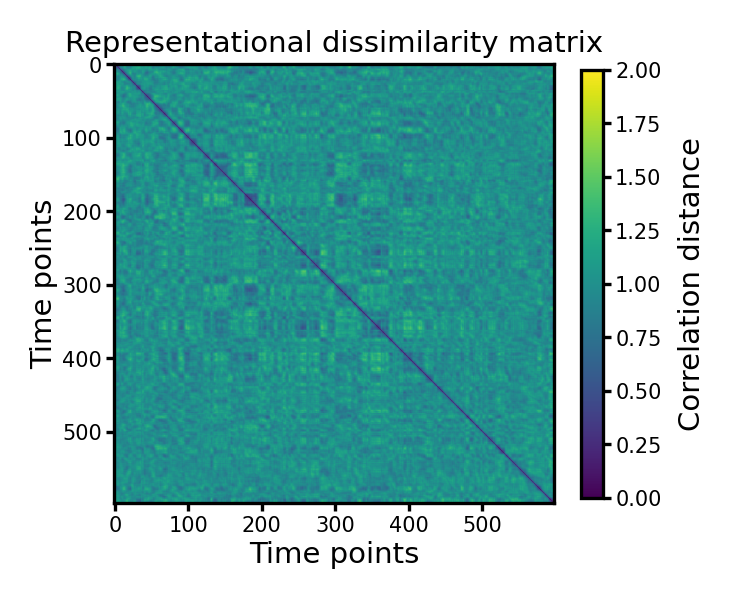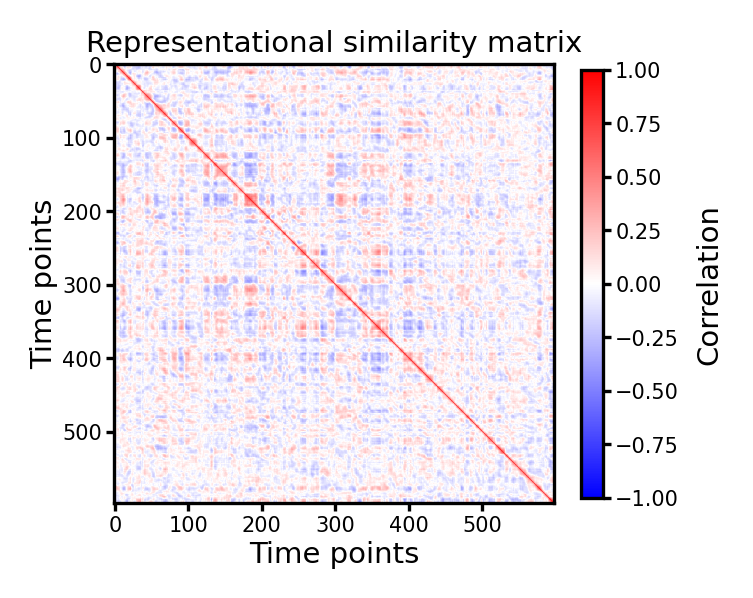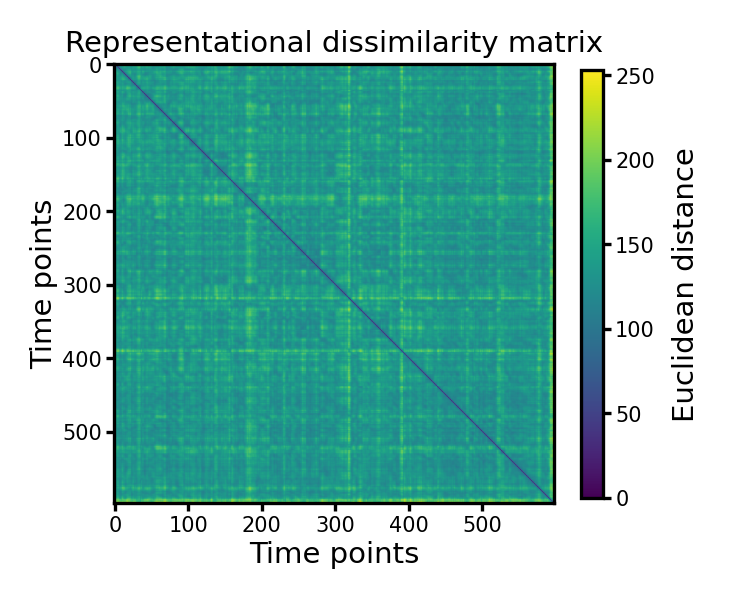Representational similarity analysis#
Representational similarity analysis (RSA) is widely used to study the representational geometry in the brain.
In this example, we use the brain responses to the 1st run of the Budapest movie, which has 598 time points (TRs). We compute the representational dissimilarity matrices (RDMs) that are 598×598 in size. Each entry in the matrix is the dissimilarity (distance) between a pair of time points.
Preparations#
import numpy as np
import neuroboros as nb
from scipy.spatial.distance import pdist, squareform
from scipy.stats import pearsonr
import matplotlib.pyplot as plt
dset = nb.Budapest()
sids = dset.subjects
dm = dset.get_data(sids[0], 'budapest', 1, 'l')
We use the first participant’s left hemisphere data, which has 598 time points and 9675 cortical vertices.
print(dm.shape)
nt, nv = dm.shape
(598, 9675)
Correlation distance#
A commonly used distance for computing RDMs is correlation distance. It is computed as one minus the correlation coefficient. Different from the correlation coefficient, which ranges from -1 to 1, the correlation distance ranges from 0 to 2, where 0 is most similar, and 2 is most dissimilar.
\( \text{correlation distance} = 1 - r \), where \(r\) is the correlation coefficient
The RDM has a shape of \(n_t \times n_t\), where \(n_t\) is the number of time points (or the number of stimuli/conditions for other kinds of data).
Vectorized upper triangle#
The pdist function can be used to compute the vectorized upper triangle of the RDM.
The RDM is symmetric, and the upper triangle and the lower triangle contain duplicate information. The diagonal of the RDM is all zeros. Therefore, the vectorized upper triangle contains all the information in the RDM.
d_corr = pdist(dm, 'correlation')
print(d_corr.shape)
print(nt * (nt - 1) // 2)
(178503,)
178503
The squareform function can be used to convert the vectorized upper triangle into the full dissimilarity matrix.
mat_corr = squareform(d_corr)
print(mat_corr.shape)
(598, 598)
Each entry is the dissimilarity between a pair of brain response patterns. For example, between time points 0 and 1.
print(mat_corr[0, 1])
r, p = pearsonr(dm[0], dm[1])
print(1 - r)
0.4217507049050603
0.4217507049050596
It can also convert the matrix into the vectorized upper triangle.
np.testing.assert_array_equal(squareform(mat_corr), d_corr)
We can also manually reconstruct the dissimilarity matrix from the vectorized upper triangle.
mat = np.full((nt, nt), np.nan)
ii, jj = np.triu_indices(nt, 1)
print(ii.shape, jj.shape)
mat[ii, jj] = d_corr
mat[jj, ii] = d_corr
mat[np.arange(nt), np.arange(nt)] = 0
(178503,) (178503,)
np.testing.assert_allclose(mat_corr, mat)
Alternative method to compute correlation distance#
Instead of pdist and squareform, np.corrcoef can be used to compute correlation coefficients, which can be converted to correlation distances.
np.testing.assert_allclose(
1 - np.corrcoef(dm),
mat_corr,
atol=1e-10,
)
Visualize the RDM#
fig, ax = plt.subplots(1, 1, figsize=[_/2.54 for _ in [6, 6]], dpi=300)
im = ax.imshow(mat_corr, vmax=2, vmin=0, cmap='viridis')
ax.set_title('Representational dissimilarity matrix', size=7, pad=3)
ax.tick_params('both', labelsize=5, size=2, pad=1)
ax.set_xlabel('Time points', size=7, labelpad=1)
ax.set_ylabel('Time points', size=7, labelpad=1)
cb = fig.colorbar(im, ax=ax, shrink=0.8)
cb.ax.tick_params(labelsize=5, size=2, pad=1)
cb.ax.set_ylabel('Correlation distance', size=7)
plt.show()

Correlation matrix#
Note that in the RDM, larger values mean larger distance and the pair of time points are more dissimilar. We can convert the correlation-based RDM into a correlation matrix, where larger values mean more similar.
fig, ax = plt.subplots(1, 1, figsize=[_/2.54 for _ in [6, 6]], dpi=300)
im = ax.imshow(1 - mat_corr, vmax=1, vmin=-1, cmap='bwr')
ax.set_title('Representational similarity matrix', size=7, pad=3)
ax.tick_params('both', labelsize=5, size=2, pad=1)
ax.set_xlabel('Time points', size=7, labelpad=1)
ax.set_ylabel('Time points', size=7, labelpad=1)
cb = fig.colorbar(im, ax=ax, shrink=0.8)
cb.ax.tick_params(labelsize=5, size=2, pad=1)
cb.ax.set_ylabel('Correlation', size=7)
plt.show()

Other kinds of distances#
There are many different kinds of distances, besides the correlation distance in the previous example.
See the documentation of pdist for a list of available distance metrics.
The example below shows an RDM based on Euclidean distance.
d_eucl = pdist(dm, 'euclidean')
mat_eucl = squareform(d_eucl)
fig, ax = plt.subplots(1, 1, figsize=[_/2.54 for _ in [6, 6]], dpi=300)
im = ax.imshow(mat_eucl, cmap='viridis')
ax.set_title('Representational dissimilarity matrix', size=7, pad=3)
ax.tick_params('both', labelsize=5, size=2, pad=1)
ax.set_xlabel('Time points', size=7, labelpad=1)
ax.set_ylabel('Time points', size=7, labelpad=1)
cb = fig.colorbar(im, ax=ax, shrink=0.8)
cb.ax.tick_params(labelsize=5, size=2, pad=1)
cb.ax.set_ylabel('Euclidean distance', size=7)
plt.show()


